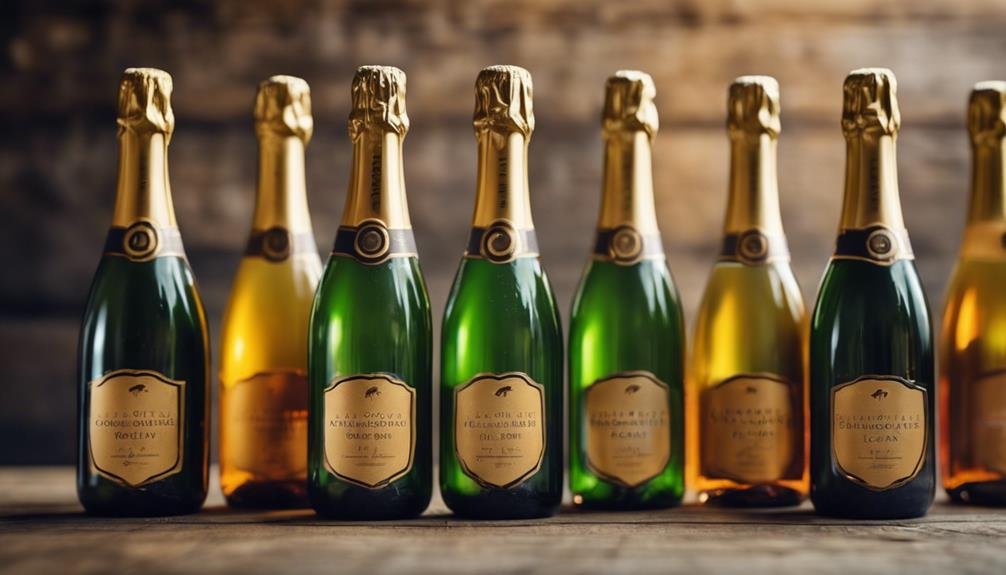Begin a Champagne journey from bone-dry Brut Nature to sweet Extra Dry types, enhancing flavors and pairings. Sugar content varies from Brut Nature to Demi-Sec affecting taste and food matches. Manage Champagne headaches by staying hydrated and consuming mindfully. Tailor Champagne choices to personal taste preferences. Enjoy budget-friendly bubbly options with Prosecco and Cava. Elevate every sip by selecting the ideal Champagne sweetness level. Discover more about Champagne's sweetness spectrum and enhance your tasting experience.
Understanding Champagne Sweetness Levels
Understanding the nuances of Champagne sweetness levels is essential for discerning wine enthusiasts seeking to appreciate the diverse spectrum of flavors offered by this beloved sparkling beverage. Tasting notes vary from the bone-dry Brut Nature to the slightly sweeter Extra Dry and beyond, impacting the overall flavor profile.
Food pairings play a significant role in enhancing the enjoyment of Champagne; for example, a Brut pairs well with oysters or caviar, while a Demi-Sec complements desserts like fruit tarts. By understanding these sweetness levels, one can better select a Champagne that aligns with personal preferences and desired food pairings, ensuring a delightful tasting experience.
Exploring Sugar Content in Champagne
Delving into the sugar content of Champagne reveals a nuanced aspect of this sparkling beverage's composition. Sugar analysis exposes a spectrum of sweetness levels, ranging from Brut Nature with 0-3 g/L residual sugar (RS) to Demi-Sec with 32-50 g/L RS. These variations influence taste profiles, with drier Champagnes like Brut showcasing crisp acidity, while sweeter options offer a more dessert-like experience.
Pairing suggestions often align with these sugar levels; Brut pairs well with oysters due to its dryness, while Demi-Sec complements fruit-based desserts. Understanding these sugar distinctions enhances appreciation for Champagne's diverse flavor notes, from zesty citrus in drier varieties to rich caramel in sweeter options. By exploring sugar content, enthusiasts can select Champagnes tailored to their palate preferences.
Managing Champagne-Related Headaches

To address the issue of Champagne-related headaches, implementing hydration strategies is essential for mitigating discomfort and promoting overall well-being.
Preventing dehydration is key in avoiding these headaches. The carbonation in Champagne can contribute to dehydration, so consuming water between glasses can help maintain hydration levels.
Additionally, headache remedies like taking pain relievers and eating a balanced meal before drinking Champagne can also aid in reducing the likelihood of experiencing headaches. Being mindful of consumption and pacing oneself can further prevent headaches associated with Champagne.
Tailoring Champagne Choices to Preferences
To further enhance the enjoyment of Champagne, selecting the ideal sweetness level tailored to individual preferences can greatly enrich the tasting experience. Understanding the sweetness scale of Champagne can help in making informed choices. Here is a table to guide your selection:
| Sweetness Level | Flavor Profiles, Pairing Suggestions |
|---|---|
| Brut Nature | Crisp, bone-dry, pairs with oysters |
| Extra Brut | Very dry, complements sushi |
| Brut | Dry, versatile with many dishes |
Consider serving temperatures to enhance the flavors – 45-48°F for non-vintage and 50-55°F for vintage Champagnes. Opt for tulip-shaped glasses to concentrate the aromas. By aligning your preferences with the right Champagne style, you can elevate every sip.
Discovering Budget-Friendly Bubbly Options

Exploring cost-effective sparkling wine alternatives can provide quality options without exceeding your budget. Budget-friendly alternatives offer a range of affordable sparkling wines that maintain excellent taste and enjoyment. These options allow bubbly lovers to indulge in the effervescence of sparkling wine without breaking the bank.
Affordable sparkling choices can include Prosecco, Cava, or other sparkling wines from regions outside of Champagne, France. While these selections may not carry the prestigious Champagne label, they can still offer delightful bubbles and flavors at a fraction of the cost. By exploring budget-friendly options, you can discover hidden gems that provide a satisfying sparkling wine experience without the premium price tag.
Enjoying bubbly on a budget is entirely achievable with these affordable sparkling alternatives.
Frequently Asked Questions
Can Champagne Sweetness Levels Affect the Intensity of Hangovers?
Champagne sweetness levels can influence hangover severity. Higher sugar content in sweeter Champagnes may exacerbate dehydration, intensifying hangovers. Moderation and hydration remain key in managing hangover effects, regardless of Champagne sweetness levels.
How Can One Determine the Ideal Sweetness Level for Their Palate?
When determining the ideal sweetness level for your palate, consider your sweet preferences and use tasting techniques. Explore Champagne's spectrum to find your perfect match. Tailoring your choice to personal tastes guarantees a delightful experience.
Are There Any Health Benefits to Choosing Drier Champagne Options?
Choosing drier champagne options may offer nutritional benefits due to lower sugar content. Reduced sugar intake can support weight management and overall health. Moderation in alcohol consumption is key. Prioritizing drier varieties aligns with health-conscious choices.
Can the Carbonation in Champagne Lead to Bloating or Discomfort?
The carbonation in champagne can indeed lead to bloating or discomfort for some individuals. Carbonation effects can impact digestion, causing bloating. Remedies include consuming slowly, avoiding carbonated beverages, and opting for non-sparkling options to prevent discomfort.
What Are Some Creative Ways to Enjoy Budget-Friendly Bubbly Options?
To savor budget-friendly bubbly, explore flavor pairings to elevate taste. Craft creative cocktail recipes with affordable sparkling wines. Enjoy a luxurious experience without overspending. Delight in Champagne's versatility while indulging in cost-effective bubbly pleasures.
Conclusion
To sum up, delving into Champagne's sweetness spectrum allows for a deeper appreciation of the diverse range of flavors and styles within the sparkling wine category. By understanding the nuances of sugar content and sweetness levels, individuals can tailor their Champagne choices to their preferences and enjoy a delightful and personalized experience.
So, whether you prefer a bone-dry Brut Nature or a slightly sweeter Demi-Sec, there is a bubbly option out there to suit every palate. Cheers to discovering the perfect Champagne for you!